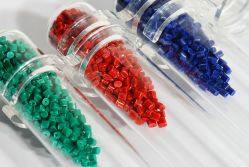
Injection molding makes it possible to mass-produce many items that we use on a daily basis. When it comes to the production of those items, there are many materials available as options, and each has its own advantages. The expert injection molders at IMCO Inc. in Spencerport, NY, discuss the top three materials used for injection molding and the benefits of each.
Injection Molders Discuss 3 Common Polymers Used for Injection Molding
Polyamide (Nylon)
 Toughness and wear-resistance are two of the qualities that make nylon such an appealing choice for a wide variety of applications. With a resistance to abrasion, chemicals, and high impact, it is ideal for medical products, sports equipment, and automotive products. It is also suitable for use in applications that require low friction, such as bearings.
Toughness and wear-resistance are two of the qualities that make nylon such an appealing choice for a wide variety of applications. With a resistance to abrasion, chemicals, and high impact, it is ideal for medical products, sports equipment, and automotive products. It is also suitable for use in applications that require low friction, such as bearings.
Polypropylene
A material that is best known for its flexibility, polypropylene (PP) is ideal for products that require high resistance to stress. Products commonly produced with PP include utensils and rugs. It is also used to produce food containers,
Polycarbonate
When transparency and high impact resistance are important, polycarbonate (PC) is the ideal choice. Items made with PC include bullet-proof glass, eyeglass lenses, and cellular phones. With a high heat resistance, it can be combined with flame-retardant materials to create a variety of fire-resistant products.
Injection molders use a variety of materials to produce products for an array of industries. The properties of each affect the overall quality and performance of the final product. If you are looking for experienced injection molders to mass produce your parts, turn to the experts at IMCO Inc. Call them at (585) 352-7810, or you can visit their website for more information about their machines and processes.
About the Business
(2 reviews)
Have a question? Ask the experts!
Send your question

